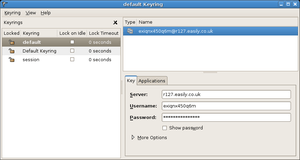GNOME Keyring
GNOME Keyring is a software application designed to store security credentials such as usernames,[3] passwords,[3] and keys, together with a small amount of relevant metadata. The sensitive data is encrypted and stored in a keyring file in the user's home directory. The default keyring uses the login password for encryption, so users don't need to remember yet another password.[4]
 GNOME Keyring Manager 2.12.1 | |
| Stable release | 3.36.3[1] (4 May 2020) [±] |
|---|---|
| Preview release | 3.37.1[2] (30 April 2020) [±] |
| Repository | |
| Written in | C |
| Type |
|
| License | GPLv2+ |
| Website | wiki |
As of 2009, GNOME Keyring was part of the desktop environment in the operating system OpenSolaris.[3]
GNOME Keyring is implemented as a daemon and uses the process name gnome-keyring-daemon. Applications can store and request passwords by using the libgnome-keyring library.
GNOME Keyring is part of the GNOME desktop. As of 2006, it integrated with NetworkManager to store WEP passwords.[5] GNOME Web and the email client Geary uses GNOME Keyring to store passwords.[6]
In 2009, a statistical study of software packages in the Red Hat GNU/Linux distribution found that packages depending upon GNOME Keyring (and therefore integrated somewhat with the GNOME desktop environment) were less likely to be associated with software vulnerabilities than those with a dependency upon kdelibs (and therefore integrated somewhat with the KDE desktop environment).[7]
On systems where GNOME Keyring is present, software written in Vala can use it to store and retrieve passwords.[8]
GNOME Keyring Manager
The GNOME Keyring Manager (gnome-keyring-manager) was a user interface for the GNOME Keyring. As of GNOME 2.22, it is deprecated and replaced entirely with Seahorse.[9]
See also
- KWallet, the KDE equivalent
- Apple Keychain
- NetworkManager
- Seahorse (software)
- Linux on the desktop
- List of password managers
- Password manager
- Cryptography
References
- Petridis, Jordan (16 June 2020). "GNOME 3.36.3 Released". GNOME Mail Services (Mailing list). Retrieved 16 June 2020.
- Catanzaro, Michael (30 April 2020). "GNOME 3.37.1 released". GNOME Mail Services (Mailing list). Retrieved 10 May 2020.
- Foxwell, Harry; Tran, Hung (2009). Pro OpenSolaris: A New Open Source OS for Linux Developers and Administrators. Apress. p. 54.
- "'gnome-keyring' tag wiki - Ask Ubuntu". Retrieved 28 February 2017.
- Oxer, Jonathan; Rankin, Kyle; Childers, Bill (2006). Ubuntu Hacks: Tips & Tools for Exploring, Using, and Tuning Linux. O'Reilly Media. p. 161.
- Jain, Manish (2018). Beginning Modern Unix: Learn to Live Comfortably in a Modern Unix Environment. Apress. p. 186.
- Neuhaus, Stephan; Zimmermann, Thomas (2009). "The Beauty and the Beast: Vulnerabilities in Red Hat's Packages". USENIX.
- Anwari, Mohammad (2013). Gnome 3 Application Development Beginner's Guide. Packt Publishing Ltd.
- "GNOME 2.22 Release Notes".
External links
- GNOME Keyring Wikipage on wiki.gnome.org
- GNOME Keyring git on git.gnome.org
- gnome-keyring Security Philosophy
